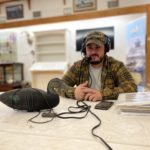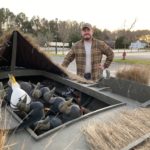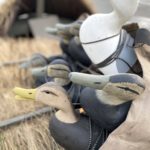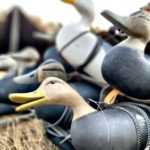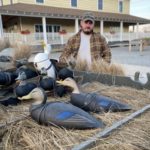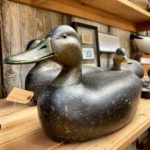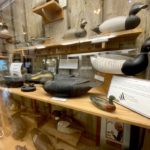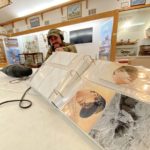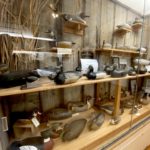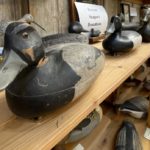Ramsey Russell meets with Bob Keeney, a 5th-generation Barnegat Bay duck hunter from Tuckerton, New Jersey. It was supposedly here, in what was formerly one of America’s largest waterfowl market hubs, that the earliest incarnations of hand-carved waterfowl decoys originated. It was here, for sure, that the deadly Barnegat Bay sneakbox hunting tradition began. What is a Barnegat Bay sneakbox, how’s it used, and how’d Keeney learn to make them at a very young age? What’s the traditional Barnegat Bay decoy rig, how important are black ducks to local hunters, and why is practicing these traditions important to young Keeney? What ever became of the hundreds of famous old duck clubs once occupying a nearby 30-mile stretch? What kind of coat did Babe Ruth once wear duck hunting and what became of it? Like a black duck form emerging slowly out of dense marsh fog, the past comes clearly into the present in today’s episode of Duck Season Somewhere.
Ramsey Russell: I’m your host, Ramsey Russell. Join me here to listen to those conversations. Man I have got a great episode of duck season somewhere for you all today, I’m still in New Jersey because it is duck season somewhere today its duck season in New Jersey, we went out and shot more black ducks and shot some Brant. Shot a bonus Canada goose that was mixed up with the wrong crowd coming with those brands. We shot some of the course divers and see ducks and stuff like it. I do see ducks in there for good measure. That’s not true. I’m presently at the Tuckerton Seaport Bateman Museum in Tuckerton, New Jersey. Why? Well, because that’s where I wanted to meet today’s guest. New Jersey has got a very rich and colorful history in the annals of American duck hunting. And I think you’re going to find today’s conversation extremely, extremely interesting like I did, Bob how are you?
Bob Keeny: Good. How are you?
Ramsey Russell: I’m fine. Did you go duck hunting this morning?
Bob Keeny: No. I had to work this morning, but Monday morning, right before I ended up going we ended up getting a few black ducks a goose. And time will tell there’s a little winged, what is a mallard hanging around the marsh somewhere and I couldn’t find, neither could my dog.
Ramsey Russell: I don’t know where to start. You know what, it’s what would mama start here? What is the significance of New Jersey to duck hunting? Because now, you know what if you asked the average duck hunter today that did not live in the Atlantic flyway, especially in New Jersey about New Jersey. They shrug and say sopranos or Boardwalk Empire, I mean really, but we’re almost like in the cradle of American duck hunting right here.
Bob Keeny: Yes, we are. And that’s funny you say sopranos. When I first I’ve done, my cousin owns a club down in Arkansas, shovelers rest in Cash, Arkansas, which is about 20 minutes north of what was that I forget the reservoir, but it was one of those Claypool. It’s about 15 minutes from there. And we were hunting in this one old guy. He looked at me and said, well, I’m shoot you’re from Jersey. I thought you’d have gold chains on slicked back hair. I’m like, well, first of all, I’m from South Jersey. There’s a big difference between New Jersey and South Jersey. New Jersey is basically all oil refineries and just a little New York’s puppet, South Jersey we are basically Alabama we are the same as the South.
Ramsey Russell: You all talk different than Alabama, but you know what it really is, its wood it’s forested, there’s a lot of water, a lot of hunters. Yeah, it’s, I would say that’s a lot more like Alabama than New York City, that’s for damn sure.
Bob Keeny: But back to what you ask, the tradition of gunning or duck hunting in South Jersey, New Jersey, in general, has dated back to go in the early 1800s when the settlers first showed up, in the winter months they wanted, they saw all these ducks flying by and they had crude weapons, the flintlock and, they needed, they wanted to try to get it. So around 1830 in Tuckerton area West Creek area, a man named Hazleton Semen created a gunning boat called a Devil’s coffin to come up into the shallow water and marsh and gun the ducks. Well after a while, the name was changed to Barnegat Bay Sneak box. So sneak box originated 12 ft. long for 4.5 ft. wide shallow draft and a displacement hall, which was, you could row it salad now you can put an outboard on it. But they started gunning and during the time they had, it was just crude market gunning, you go out there with a two gauge, four gauge and a punk gun and just flock them within the Barnegat Bay area. We used to have rafts of broad bills that would black out the day sky, they were so thick, they would just drift over and skull over to them and fire the punk gun into the flock which flocking it was called, then around the 1890s I believe that was outlawed federally. So that just went into sportsman hunting and hunting to survive after the market hunting stopped. Which also turned around to a gun clubs being made.
Ramsey Russell: We’ll back up just a minute Bob. You were telling me something about earlier today, about the decoys and about the significance of where Tuckerton is located and how your thoughts are that the decoy, the carved decoy originated here?
Bob Keeny: Yes, Tuckerton and the Barnegat Bay decoyer, Tuckerton decoy. There’s a within a 30 mile area from Toms River to Tuckerton. It’s a large body of water called Barnegat Bay, Manahawkin Bay, Tuckerton Bay and Great Bay. It was all considered in my notes as the 3rd port of entry for the Continental Congress back before we were the United States of America.
Ramsey Russell: Third port of entry.
Bob Keeny: And what that means, we had big trade and trading options to go through the country. And that deemed market hunting and gunning in general, they needed supplies and instead of going to taking a ship or taking a horse drawn carriage out to Philadelphia to work and by web shotguns, whatever they deemed we have to start doing it ourselves. So guys around, they started carving their own decoys. Now, whoever originated the decoy in South Jersey it’s hard to tell, but there were few, Joe King is always one that comes to mind who was a little north of us in Eagles Woodman Manahawkin his dates back to around the Civil War era. We don’t know an exact date, but most decoys around the Civil War era that he was carving. There was also J. G. Downs who carved here in Tuckerton, which they all similarly route that resembles their own decoys then coming in and those decoys, they became so well know they were actually shipped by via train down to other gunning clubs outside of New Jersey. I have one of Joe kings, it’s a black duck. It was actually shipped to the Potomac club down in Virginia or Maryland I forget exactly where it’s at. But the only reason we know that is the Potomac club they made silver dollar decoy weights and they poured them themselves and it was about the size of the silver dollar. You look under the decoy I have and there’s two silver dollars waited on the bottom of the boat. And that’s the only reason we know that his decoys ended up being shipped. And then you can see similarities from Marilyn Carvers in Jersey decoys, there’s a few that will resemble a Tuckerton guy. He is basically known as the grandfather of decoy carving in Jersey. Harry V Shourds. Shourds only lived, he lived right across the creek here where we’re standing only 400 yards away and he was the first ever commercial decoy carver. He was considered the exact number, isn’t known, but his decoys now are an original paint are worth upwards of over $100,000.
Ramsey Russell: Yeah, I’ve heard of course. I’ve heard 200. That’s incredible, isn’t it?
Bob Keeny: It is.
Ramsey Russell: He probably rolling in his grave knowing how he gave them things away for a quarter.
Bob Keeny: I don’t own it, but I’ve seen it. There’s a receipt that he carved that he rode out to a guy for Long Beach Island. 12 geese decoys for $24. If you bought 12 Geese decoys or goose decoys from an auction today, you’d be looking over a million dollars. Just for some old cedar hollow would decoys.
Ramsey Russell: And you probably wouldn’t throw them in the bottom of a Barnegat Bay sneak box and take them out hunting.
Bob Keeny: I might be that crazy one that does because I still do that when I buy a new decoy that was at auction. I have to throw it back in the water because that’s what it was deemed to do, granted. If I paid $100,000 for a bird, I might not, but it’ll be in my back deck, I got to throw some line onto this and see how she floats in the water.
Ramsey Russell: I got some friends like it and I sure do. Tell me this let’s back way up. You’re born and raised here. Your dad and grand dad, did you grow up hunting? What is your hunting origin?
Bob Keeny: My hunting origin is my dad hunted, my grandfather. Both sides of my family hunted. I’m 5th generation Tuckerton in here and I even have, from what I was told the second great grandfather was a market gunner here on Barnegat Bay. I wish I had his punk gun because I’d probably end up, but I’m glad I don’t, I’d end up getting too much trouble taking out some bufflehead or big flock of black ducks on the marsh.
Ramsey Russell: But I can see that would be trouble today.
Bob Keeny: But I grew up on the Bay. My family and I, we own a marina right here on the creek, but I grew up around decoys, boats, not just even duck hunting. There’s pheasant hunting deer hunting. I mean right now if I’m not duck hunting, I’d be out in the woods. This is six day fire arm shocking week for Jersey or as I like to say, the Orange Army the deer clubs walking buck a week, just guys walking through the woods yelling, Yo buck, hoping a 6 point – 8 point or run out in front of them. But, that’s all I really know is duck hunting, going out in a boat, claiming my roots are so deep here. If they even cut my roots I’d still be stuck.
Ramsey Russell: Tell me stuff. What did growing up around your family? Did you ever hear any stories? Did your granddad anybody tell you the story about his daddy being a market hunter? Did you ever hear old tradition passed down?
Bob Keeny: No, there wasn’t too much because it was just so long ago. But there have been stories I know of one, my grandfather when he was young, he was going out black duck hunting with a friend of his and one of the old Tuckerton guys, I forget his name, I forget right now. But they were sitting in a tip line which is basically just a pit dug into the marsh and you’re right on the side of the water waiting for him. And it’s right before for light. And the gentleman told my grandfather and his buddy don’t shoot until its light. Well, they’re sitting there waiting, all happy that they’re hunting with this old timer. And all they hear is “Bang bang”. And my grandfather yelled out to him and said you told us not to shoot until light. He said you’re right, I did. But these two black ducks were right there, I had to.
Ramsey Russell: You know, it reminds me of a time hunting down in Mississippi with an old timer. Very, very old timer. And we went to an oxbow, he just come into the shop one day and we started talking and next thing I know, he called me up and said I’ll go out there with you in the morning. And, my old battery operated light, there’s a near spot real dense cypress we had to go through and that’s right with my battery operated light, decided to go out. And I was like, Oh my Gosh are we going to get things like just calm down, calm down. And it was either just into the black, he started pulling so I navigated through the shoppers and he said no where do you want to go? I said well I thought we’d go to the mouth of Tipo out there right there in the pitch black dark. He took him, he’d been hunting that place for 60, 70 years since in the World War II and I pulled a blind the ducks were flying. As a matter of fact, that was the last black duck I ever saw on the state of Mississippi. This was 20 years ago and I started shooting ducks and like Mr. Golden getting close to living here, you might want to shoot and he said boy, he had a single shot sears and Roebuck shotgun. He says I hadn’t shot of flying duck in 50 years and I don’t intend to start this morning and it’s fun hunt with them old time, they do it their way or no way.
Bob Keeny: I have funny you said about the light. I have one good friend that I have, he stopped gun in 2013 but I still talk to him all the time. I told them how my buddy likes have a big led light bar on his on his boat and he likes drive through the marsh, get into the spot early. And he always tells me you can’t have that light. That light will scare up every black duck in the marsh when you’re going out there you go out in the pitch black. If it has to take you two hours it takes you two hours. You just going to leave early. But the second you shine a light on the water next to the marsh, that black ducks going to either wake up and walk swim away or he’s just going to leave and you’ll never see him again until the next morning.
Ramsey Russell: You believe that?
Bob Keeny: I don’t have a spotlight
Ramsey Russell: Well I didn’t see any led light on your boat out front.
Bob Keeny: I have a little light, just a little one that just in case I break down, the light goes SOS on it if my phone dies. But, I like to let my eyes adjust and run those marsh.
Ramsey Russell: Back at day and I still know people that are just blaze off into rice fields where they’re going with four wheelers. So after decoys and back off a little ways and go and walk back to the blind and hunt and I don’t like to do it that way. I really think there is a lot to be said for just like the whole the hunt back home on our camp. I’ve been, I like to see the shine of the water. I know where I’m going. I say that what the outline of that willow tree or there’s a clump of button bushes I’ve hunted for 20 years and to me it’s a lot of satisfaction walking as quietly and with as little light as I can. I actually see better in dark once I let my eyes adjust and I do with that little come up with that beam of light on all I see where that beam of light, but you know, I know where I’m when I start seeing outlines, it is a little satisfying to be get your decoys out and walk back to your tree and sit there and hear ducks quacking around you. So, you know, you didn’t scare them all off, I like that way.
Bob Keeny: I’ve had one day I set all the stools out, we placed them and I’m just sitting there. It’s maybe 05:30 in the morning, another hour and a half until shooting time. I’m just sitting there and all you hear, just like you said, you’re quacking and then I start seeing Silhouettes. And I had black duck swimming through the decoys and they didn’t know what they were, they said that looks like a duck, so I’m just going to swim over, they must have some food over there and they sat there until shooting time and then we unloaded on them.
Ramsey Russell: Yeah, of course. What are some of your early recollections growing up hunting with your dad and granddad judging from you are very traditional hunters?
Bob Keeny: Growing up, my first, my earliest duck hunting trip, I remember getting into my dad’s Garvey and we were going out to Horse Foot Cove here in Tuckerton and we were going to go diver hunting. So we go out, he throws rigor herders that he painted up, they were black ducks, but he painted up as bufflehead and broad bill just because he liked he liked the bigger body decoys than me. So I remember just sitting there freezing to death because it was middle January and all I had was pair cohorts, some rubber boots and I’m just sitting in a pond box next to him. And he said all right, these ducks are dumb, but you can’t move, we can talk all you want until they start coming in but you can’t move their eyesight is too good. So we ended up sitting there and I remember he crippled one this hand broad bill. He crippled us swimming away but she was going with the tide. So he didn’t want our dog to go out and get him. He said bobby, here you go get it. He gives me a single shot H&R 410 and he said go hit that cripple again and then we’ll go out in the boat and get it. I said, but dad, I’m only six, I’m not allowed to hunt. He said its 4 10, you’re not going to fall on your butt. It’s not going to hurt. Just go and shoot it. So I get out of the box, walk over to marsh where he’s running away and I with him moving so fast just from swimming and going with the tide. He told me to lead him a little bit so I hit him. I shot ended up hitting them and we went and get it hand broad bill, beautiful and full plumage and what she got on her, she got a little piece jewelry on her leg. Yeah, I still have that sits in my gun safe.
Ramsey Russell: Have you shot many bands?
Bob Keeny: I’ve only shot about four or five. That’s about it. So not too many. I know a bunch of guys that always got bands. There were just luckier than me, but I’m not in it just to shoot bands. I’m in it more for this tradition.
Ramsey Russell: I knew that the minute you pulled up, you pulled up in a Chevrolet truck, pulling a 12 ft boat by about four ft wide, very traditional Barnegat based neat box. Tell me, did you make that yourself?
Bob Keeny: I made it myself with my grandfather and dad helping me. I was about the second boat I helped build, but that was the first one. I was lead builder on it instead of looking over the shoulder and my grandparents and dad. We made a little bigger I wanted an elongated cockpit. Not that I’m a big guy, but I like having foot room. I hate sitting in a sneak box and my waiters are stuck up underneath the ribs of the boat. So we don’t elongated cockpit. That was all my idea. And after I started cutting and my grandfather walks over, he’s like. What the hell are you doing? Where are you going to put the decoys? I said, we’ll put them on the bow or in a bag. He’s like, I don’t. He walked away. Then he sees it when it’s all set and done and he sits in it and he’s like, I should have thought of this 50 years ago. This would have been nice. I said, yeah, that’s why it’s a Cadillac. But now the sneak box that we built and I built and we built their white cedar swamps cedar as I call it Jersey cedar. All white, no knots and the ribs are, we did oak. Normally they’re made with cedar oak or, and it’s all traditional afloat right but the difference in my sneak box and a regular one, like a sailing one. Mine is a planning Hall. So it’ll plane instead of the bow just sticking up when you have the outboard on it and push it in the water. She’ll actually plane over. And you’ll go a little bit faster. Not, that it’s a steep speed demon with 15 horse, but I go about 20 miles an hour instead of 10. So, but she’s still, its safest 12-foot boat I’ve ever been in. Like, can guarantee it will be for anybody that doesn’t know anything about boats.
Ramsey Russell: What you all make it from, what kind of materials you make it from?
Bob Keeny: White cedar, swamps cedar. So it’s just wood and some fiberglass and silicone bronze screws.
Ramsey Russell: And what were you telling me your granddad also opposed to using fiberglass?
Bob Keeny: Yes. My grandfather hated that I used fiberglass, when he said he never owned a boat with fiberglass on it. He’s always had wood boats. When I was about six years old, he built me a 12-foot Garvey, which is another Jersey-style boats, flat bottom, and shallow draft. He built it for me and he said you have to cotton it seem compound and paint it every year. So there’s young me up until about 14 years old that was still pulling the cotton out every winter.
Ramsey Russell: Where do you mean cotton it?
Bob Keeny: When you cotton the seams of a boat there about an eighth of an inch wide to about a quarter inch. And cedar will swell to almost as tight as frogs butt but it helps it when there’s cotton, you run a line of cotton like from a shirt, her boat cotton, you push it in the seams and one that and then put team compound over it. So like a caulk or silicone that wood will get wet and that cardinal get wet shell, she’ll get so tight that water will not leak it all through it. She’ll just sit there watertight until you pull it out of the water.
Ramsey Russell: Oh big time. You know hunting over and Azerbaijan people have heard me maybe sail, described this before and some of the short films and pictures we’ve taken it. It’s very, very, very traditional hunting. They’ve got these tiny little P-rose, just flat bottom 12 ft. boats. Guys standing back and it’s just raw lumber put together and skills drafts in real shallow water. But they literally just caulk it with mud. Yeah, they’ll come in after before the hunt and dip the water and caulk it with mud and often go hunting. If it leaks a little bit while we’re hunting, re caulk it you know, reach down and grab the plane and caulk it and come on back in. It’s just simple.
Bob Keeny: Well, that’s all a Garvey basically is as a P rose or a bateau, that’s all and that’s where the Garvey originated. It originated well, the Garvey itself was created here in the 1700s, but it was off the same design as in English bateau or French bateau, just flat bottom, slab sides and just get into shallow draft water.
Ramsey Russell: I noticed, that’s your hunting boat you came up in still got shotgun case up and laying down and your decoy, you bag of decoys and it’s a tiny bag of decoys.
Bob Keeny: Yes, up here in this area, I was always taught by my grandfather and a bunch of old timers. You don’t need a lot of decoys, and I was always told you got to use seven black ducks for a puddle duck rig, seven black ducks and one Seagull. You got to have a Seagull decoy for confidence for black ducks. They’re very smart animals.
Ramsey Russell: They’re weary. Black ducks are very weary.
Bob Keeny: They do not like going anywhere where they’ve never been before. And I was always taught you throw a Seagull out there, they’ll be more comfortable in their surroundings because when you’re scouting and they’re looking, you’ll see black ducks, but you’ll always see a Seagull or Blue heron or an Egret, they’ll be there because the heron and the Seagull, they’re not that they’re skittish, but they know when something’s not right, so they’ll always leave in high time. So I’ve always run seven black ducks in the Seagull for the 8th decoy. And I’ve been not ridicule but always laughed at the boat ramp or something. You’ll see guys coming. You only go out with that many decoys. I said, that’s all you need. Tell me anywhere up here in Jersey that you see a Flock of 40 Black Ducks in one area, except maybe inside the marsh where they’re sleeping or bedding down.
Ramsey Russell: How do you put those seven or eight decoys out? Are they one big group?
Bob Keeny: No, I spread them out as far as they can go.
Ramsey Russell: One here two there?
Bob Keeny: They’re normally in pairs. So the ones I showed you, they’re rigged up as pairs and then I’ll have a single here and there and the pairs will go. So I’d probably say 20 yards apart, 30 yards apart. Because from what I’ve always noticed, black ducks, they hang out together, but that they were ahead of the COVID 19. They like to social distance themselves from everybody, even their own kind.
Ramsey Russell: Where do you put the Seagull?
Bob Keeny: The Seagulls far out in the flock that’s maybe 60, 80 yards away. That’s so far away from everybody. But they know they’ll see that white and be like, all right, we’re pretty good. They’ll see the white head of that Seagull. I’ve got a couple looks from the wardens when they stopped me thinking I’m hunting seagull.
Ramsey Russell: What would think being from around here, they know when you go out, that’s your target is black ducks do you shoot anything else that comes in or?
Bob Keeny: It really depends what I feel like doing. I mean you’ll have bufflehead, you’ll have gadwall, mallards will come in, then you’ll have like a hooded mergansers or they’re just common mergansers, you’ll have everything come in. But if I’m black duck hunting, I don’t see the need to shoot another duck if it comes in because if I’m not actively targeting it, I’m not going to shoot it.
Ramsey Russell: I’m trying to establish, I mean around here, the way you’re set up with the Barnegat bay boat with your traditional spread of seven black ducks and a seagull you’re going in morning, you get up in the morning to go duck hunting. You’re chasing a limit of black duck, how was your duck season not too long ago when the limit was one black duck?
Bob Keeny: So for a lot of guys that it was probably a terrible time. For me it didn’t matter. I mean you can ban duck hunting tomorrow on me. I’m still going out there and throw my decoys and watch the birds work to me it’s not about killing. The limit could be 30 black ducks. If I shoot one, I’m happy because I know what I’ll eat and I know I’m not going to go and just keep killing to kill because that’s just what I’m not about that, I’m more of tradition. I want to keep it going. And whoever I can teach, you don’t need to go out and shoot 40 ducks to be a good duck hunter. You can go out and shoot one duck and be a great duck hunter because you know how they work. You know how the animals work. You know where they’re flying. You know their flight path you know that they like these certain areas these time and months and you know when you’re going out well you can sort of tell a juvenile duck from a full grown adult at least I’m pretty good at it, I can tell. But other than that it won’t affect me at all.
Ramsey Russell: You play a clean game. That’s kind of what how I describe it, you go out. You know it’s one thing I’ll say the limit six hunting down south. It’s one thing if you could have shot six and come back with one. But something else if you could only shot one and you killed him. You play that clean game. It’s a drake or is this you know, I’ll admit to you this I’ve hunted Mexican ducks down in Sonoran Desert. And oh my gosh, I spotted drake. They’re both, they’re dark mallard like birds and not as dark as black duck more like a model duck. But the drakes are notably bigger for some sunshine you can see the bill sea quack sea doesn’t [**00:32:50]. And I feel 99% certain I can pull the trigger and kill the drake if that’s the deal. And I tried, I’ve tried that down here the last few mornings. Shooting black ducks and that doesn’t work if the sun is right. But often it’s not always just hanging low. You can see the bills perfectly, you know, they’re above you and the sun below or something like that and its delighting sometimes tough and I’ve had a hard time just judging by side a big duck and little duck come by I shoot the big duck it’s a big hen, that’s tough hunting black ducks like it.
Bob Keeny: Then you also have you have those, the real migratory black ducks, there’s big Canadians that come, I don’t know if you come across them yet here, but you’re talking a regular jersey black ducks about 16 inches long. Sort of thin not too fat, but then you’ll get these monster Canadian black ducks have come in and they’re just massive to the size.
Ramsey Russell: Big Red Leg.
Bob Keeny: Big Red, Big old bill, big old head. They’re just monsters.
Ramsey Russell: We shot some, I’ve shot some smaller ones into bigger with four I shot one a few days ago, maybe last week, days running together over in New York. That was just enormous, it had real reddish orange legs and just absolutely stunning. We shot a couple of, I’d say a couple of his close cousins down here too, but that’s just given a choice. Our host asked us today at the boat ramp would you all want to go try Brant tomorrow or a black duck. I’m like black ducks, something about them. I just love them.
Bob Keeny: Now there are abundance up here but I know and the outside of Atlantic, they’re pretty scarce.
Ramsey Russell: Yes sir. They get harder as you go west. Do you ever target Brant? Do you ever hunt Brant?
Bob Keeny: I hunt Brant. I do it maybe twice a year just out of tradition. I brands probably my favorite bird gun. They’re the best looking bird in my opinion. I love how they look just in the water. I love how they’re just chirping at each other and I’ve always done a traditional tuck in a Brant shoot just me and a couple buddies. We throw out about rig 18 Brant just sit there and let them chirp, you’ll never shoot. I’ve always told my buddy you don’t shoot them on the first pass, you have to wait because that’s them just checking you out. That second pass, they come back you unload on them let them wait and then you just sit back down. They’ll circle again. They’re not the smartest animal in the world there.
Ramsey Russell: I like a dumb duck, and a duck goose.
Bob Keeny: Other than snow geese destroying their population up in Nova Scotia. It’s just because they’re dumb. They’re dumb. They’re not, you shoot at them. They lay back down there like, oh look! I’m over here again. But, but they’re just fun to go. I mean, Jersey is just had an abundance from decoy makers and just going around looking of Brant. From the whole Jersey Coast ever you won’t find one decoy maker that hasn’t made a Brant decoy. And it’s however, their interpretation of a Brant. That’s what I love about our Jersey decoys you see influences from each area that you have general idea of on where the bird came from, who carved it. But a decoy to me, it’s the eye of the beholder. He carved that bird because that’s how it looks like to him and to go off top, that’s the reason I started carving other than tradition. I hated seeing going out and having plastic decoys because I knew our area had an abundance of decoy makers and just rich tradition. So I’d say, well, I’m going to try to learn carve, my family never carved, they always thought decoys and, but I had a couple good friends, older friends that they’ve carved their whole lives and they took me under their wing. And life is too short to me to hunt over plastic decoy because if you can have something yourself that you physically made, whether it’s crude and the paint’s not good on it, but if it brings a duck into you, and if you get it or not, you’re not mad you’re amazed that animal thought highly enough that your bird worked. So that’s how I’ve always looked at it. But I know I ramble up, but back to the Brant.
Ramsey Russell: Well, I really was digging in the conversation because I had a brief spiel a long time ago, I still haven’t painted a dozen of them, but I did carve some decoys and I don’t take them out all the time. They’re big clunky cork not nearly as attractive is that they don’t have a style. I just decided to carve some, bought a few patterns and chopped away and sought away and I didn’t know what the heck I was doing, but it’s unbelievable when I kill ducks and I’ve killed, so it takes it to this level of connection I can’t explain. It doesn’t have to be an art, it doesn’t have to be super realistic. I mean, I am absolutely determined to go shoot ducks to film shooting ducks over black pop bottles because we’re hunting an animal with a pea sized Brant and it just, it doesn’t take the latest greatest most scientific anything to hunt this bird, it’s just the fundamentals. But when I think about decoy carving and I think about being in that shop how it smelled when that wood hit that pine and just the thoughts what are you thinking about why you carving decoy? I’m thinking about killing duck I’m thinking about how this duck’s going to look like, sitting in the water, how that duck is going to react and it takes that to a whole new level.
Bob Keeny: Oh yeah. I’m the same way I when I’m sitting there carving, I’m just sitting there smelling the cedar because jersey birds are made out of cedar, they’re not pine, they’re all white cedar heads, white cedar bodies and they’re hollow or a dug out, but we hollow all the decoys out so they’re lighter. But I’m sitting there thinking how is this bird going to look in the water? Is the paint realistic enough to me that it will look like a black duck when a black ducks flying over? Is he going to look and say that looks like one of my guys? So that’s all.
Ramsey Russell: How old are you bob?
Bob Keeny: I am only 28 years old.
Ramsey Russell: Yeah. I would say you’re a very young man to be so traditional. I mean, I find it interesting that you’re about the age of a lot of guys are still in that phase or something else matters than tradition. When I was 28 years old I’m going to tell you I was blood thirsty killer and I just want to have a strap every time and I threw as many decoys as it took and went and hard and whatever, you know, that guy, I was in a totally different place when I was 28 years old. How did you end up here and why is hunting over eight wooden decoys in a boat you built yourself so important
Bob Keeny: To me, it just has to be my roots are deep here in South Jersey. I’m fifth generation out of Tuckerton. You know, I was always instilled and dug in my, my head, my family always said your name is the best thing you have for you. It doesn’t matter how much money you have, you got to have a good name and you just got to keep traditions alive because if you don’t keep traditions alive, you’re going to lose everything. You could be the richest man in the world. But if you forgot where you came from, it doesn’t matter what you have.
Ramsey Russell: Absolutely. That’s very well said. You talk about those black ducks, you know how many you can eat? Do you have a favorite way you like to cook black ducks and Brant and some of these other species you shoot?
Bob Keeny: Black ducks, I like roasting them. Just a roasted black duck throw onion in the cavity, put a little orange, put some orange zest over top of it and just roast it.
Ramsey Russell: Salt pepper.
Bob Keeny: A little orange. Yeah, that’s about it.
Ramsey Russell: Put onion in the Cavity and then put it in the oven 350°.
Bob Keeny: For about 40 minutes. So it’s about, so it’s like a medium rare basically like steak that and my girlfriend, she just tried duck for the first time last Wednesday night had Black duck first time and I wasn’t going to roast at for her because a sort of a acquired taste when you’re roasting up with the orange and the onion. So what I did was I breasted it for her and I did a Maple Cayenne Glaze.
Ramsey Russell: Elaborate I want to hear more about that.
Bob Keeny: All right, so I pan seared, I kept the skin on the breast and the fat pan seared it real put the breast in the pan ones cold and then just with a little butter salt and pepper pan seared both sides. So it gets just good, you put the maple glaze on it as it’s in, then you just put in the oven once it’s pan seared here.
Ramsey Russell: So what do you call maple syrup?
Bob Keeny: Yes, you got about a couple of maple syrup and a quarter ounce of cayenne pepper and a tablespoon of brown sugar mix that all together. Let that all sit and render you have that duck breast in the oven for about four minutes. You pull it out.
Ramsey Russell: Back up now I’m going to, put it skin down on the pan, butter, flip it over for a little bit over sear both sides here put it in the oven,
Bob Keeny: Four twenty five for four minutes, pull it out. Glaze the one side, put it back in for four minutes. Pull it out for four minutes again with the glaze side up, pull back out, and put that second glaze on the other side on the opposite side. Keep it out of five minutes. Let it rest, let it rest. Let that pan that’s still hot. Get that glaze onto the top, set it and forget it.
Ramsey Russell: When you’re browning your meat like that both sides in the skillet, you’re not running it real high and just putting a hard sear on it are you?
Bob Keeny: No, you’re starting the pan cold because with the ducks it’s fatty, you let that fat render in the pan with it, so you get all that good flavor, and you flip it on both sides so you get a nice brown sear on it.
Ramsey Russell: Are you timing it or going by?
Bob Keeny: I’m going by looks every ducks different to me.
Ramsey Russell: Exactly. I do something very similar I get the skillet hot a little bit of fat boom throw it hot three minutes. I make a glaze, butter bourbon, jelly something another and then put it on when I put at oven for four minutes it’s done. When you cook it this way is it still medium rare?
Bob Keeny: It’s a little past medium rare. It’s about a medium. I wasn’t going to throw a medium rare on for never having it and then for Brant, you’ll like this Brant recipe. All right, you breast the Brant. That’s all you do. You breast it you put it on a cedar log with salt and pepper. Then you put it on the grill. Wait for that log to smoke get that nice aroma when the Brant has a nice cook color look, you pull it out, you look at it, you throw that Brant in the trash it start all on the wood, I swear to you.
Ramsey Russell: No, I’m going to tell you one better now because we’re going to post something on. I was scared here. I was taking notes thing and no, I’m that old joke.
Bob Keeny: I make Brant, I make Brant jerky, that’s about it. There are ways to cook it
Ramsey Russell: Well my host here. I ate some of the other night and saw it up real nice and I’m like man, this is good because well that’s Brant I go no way man, because Atlantic Brant is terrible. Everybody for 20 years said you can’t eat them. He said well you’re eating them. And I said well that’s good.
Bob Keeny: Well, it all depends to if you get them early season, they’re really not too bad. I would cook them like a black duck once you get mid-season January when they really get into that that cabbage grass and you really look at their butt and it’s green, you don’t want to eat that because all you taste is that seaweed cabbage and that’s all cabbage.
Ramsey Russell: I know he’s taken the fat off and he is soaking it in, he going to show me tonight we’re going to eat something soya sauce and some different things and then grilling it and it’s and I posted that up that day and I was like, well that’s some kind of he’s messing with just pulling your leg, that’s chuck roast and it aren’t, Brant it’s good, he cooks and I’ve heard that a lot of these marsh black ducks will get strong too.
Bob Keeny: They get strong. That’s why you got, I forgot to say, I brined it for two days
Ramsey Russell: brined it for two days. Saltwater.
Bob Keeny: Saltwater just brine it first day after you breast it sit there in salt water, rinse and repeat the next day.
Ramsey Russell: Okay.
Bob Keeny: Because up here in Jersey you get that real strong saltwater marsh flavor. So it’s tough to get out. I mean even and you won’t get it completely out. I even had it on when I had it on Wednesday. I still, I’m like that piece there he was eating some mud right there.
Ramsey Russell: Do your dad and granddad still duck hunt?
Bob Keeny: No, they don’t.
Ramsey Russell: Why?
Bob Keeny: My grandfather when they back in the 80s, when they dropped it down to two Black Duck, he said it’s not worth my time anymore to take a party out to kill two black ducks apiece.
Ramsey Russell: Was he a guide?
Bob Keeny: He was a guide.
Ramsey Russell: Okay. I bet people would pay him too.
Bob Keeny: Yeah, but he was remembering growing up with his dad, they would just gun black ducks because that’s that was a source of food for him. And when you can’t do that anymore. He stopped gunning now. He gunned with me once when I was a kid. And my dad stopped gunning just because he didn’t feel it anymore. He just not that he lost interest, but he just didn’t want to anymore. He got tired of gunning, he just wanted to relax, which I understand, but he did say when I have kids he will go out gunning with them.
Ramsey Russell: Marsh hunting is arduous.
Bob Keeny: Yes. It is.
Ramsey Russell: I mean it takes a little effort to get out there on that marsh, even if you’re running mud motors and aluminum boats, it’s a mess, getting out there and doing that kind of stuff. Do your dad and granddad ever talk about anything else that’s changed besides the limits they ever talk about the good old days what it used to be like.
Bob Keeny: They talk about the less of ducks, they don’t believe there were as much ducks any more than there were, I mean my dad, when he was growing up, you’re still allowed to bait ducks and my grandfather that’s all they knew was throwing out 400 pounds of corn on a Friday night bating those broad bill and bufflehead and black ducks, so that’s what they miss, they miss being it because my grandfather always had an idea of it when they started building up the area, you started losing more habitat for the ducks come and stay. There is one area he always talked about Reams and Meadows, which is now called Beach Haven West, massive development of just it was all on marsh and that would hold thousands of black ducks he would say and people would bait them, so they had a food income. But there was also natural food there for them. There was going back into the freshwater had the wild rice that they would come and swim. But once you start taking out habitat, there’s not really anything for a duck to come and stay. So I mean I’ve always been a component say let us bait. I’m allowed bait for deer. Why can’t I bait for a duck?
Ramsey Russell: That’s a good question. And I don’t know. I mean if the limit six, what does it matter if I shoot him at night over corn with an unplugged shotgun? I’m not saying we should do that. I’m just saying why not? I don’t know.
Bob Keeny: Yeah, but I understand where they come. They don’t want it, because not everyone is going to retain to two black ducks or one black duck. Whatever the limit is, they’re going to sit there and have £400 of corn and sit there for eight hours and take every duck out there. A select few will.
Ramsey Russell: Some will, few bad apples.
Bob Keeny: And that’s what hurts us.
Ramsey Russell: Last question I’ve got is, you were showing me some real interesting research you had done before we started recording you’re working on a book project? Tell me a little bit about this project.
Bob Keeny: I’m working on a basically a picture history book of the Barnegat Bay gunning clubs of my area starting from Barnegat inlet all the way south to the mouth of the Mullica river and I’ve been doing the research about four years and there’s been over 100 gunning clubs, Duck hunting clubs in our area, which is only 30 miles wide, or 30 miles long.
Ramsey Russell: Wow. Well, what happened to all those camp house? I mean, tell me a little bit more about it.
Bob Keeny: There’s all the gunning clubs, there’s 4 of them left out of over 100 and the reason for that they’re privately owned, but back in the 70s, early 80s actually a great initiative came around Edwin B 4th site, a wildlife management area came and they bought up all the marsh for protection. So you can’t build on it anymore. But with that, you lost leases. So these marshes, these gunning clubs were on leased land from property owners. And when the federal government came in, those leases expired. So either the gun clubs, they became too dilapidated and run down and just fell into the water.
Ramsey Russell: So far south is a federal refuge.
Bob Keeny: Yes, federal refuge.
Ramsey Russell: National Wildlife Refuge. That’s crazy. It’s too bad. A lot of history.
Bob Keeny: Yes.
Ramsey Russell: what are some of the interesting stories and stuff you’ve come across?
Bob Keeny: I’ve come across there is a really famous club right inside of Barnegat inlet called the Sag Island Club. That is now owned by the state of New Jersey as a water research and a wildlife research area. It’s the original clubhouse still, which dated back to the early 1880’s that had President Grover Cleveland as a regular guest there to go gunning. We have photos of Grover Cleveland at it. I can even look through the book I probably have one in here of him standing then there was coming closer to us here Carvel Island Club in Surf city New Jersey. That was a big hub for Babe Ruth. Babe Ruth loved gunning here with another famous baseball player that was from the area his name was Doc Kraemer. Doc Kraemer played the same time Babe did and introduced Babe to gunning down here. So he would come with, there’s even one picture of Babe fishing with Doc and Louis Garrick but there’s one story that an old timer, he’s 96 right now. I still sit in and talk with him sometimes. He was about 13 years old at a one club dinner point club and his dad had Babe as a guest. Well, Babe came up by boat and a big fur jacket come up to the clubhouse and they started drinking it like 03:00 PM until 08:30 PM. So in the morning he was still a little three shades to the wind and he ended up coming out getting ready to go into a boat, big fur jacket on still, falls into the mud. Well Babe was a bigger guy at the time. He told me and got stuck, couldn’t get him out. Had to call another gunning guide from another club to help them get out of the Marsh and his jacket was ruined covered in bay mud smell, so the man’s dad told him you got to go take this jacket and sneak box and you’ve got to row it around the bay to get all this marsh mud off of it. So he ended up doing that that same day Babe is in the pit blind and he gets up to go to the bathroom, drops gun in the mud says they checked. Babe said he checked it, said it was all good, clean, he shoots power blows up right in his face. But that gun still around it’s in a private collection in Manahawkin Babes gun used. But there’s pictures of babe that he wrote to the clubhouse is to the Carville Island Club to thank them for a gunning club for gunning them. I should have it here.
Ramsey Russell: That’s an impressive collection. You’ve got some old photos and stories and stuff.
Bob Keeny: Like, when I say Pip line, the Pip line in the marsh. It’s dug right in there like. But these are all of the history. Here we go.
Ramsey Russell: There it is, yeah. Look at that.
Bob Keeny: That was a signed picture that Babe wrote to his one gunning guide.
Ramsey Russell: That get him into some good places to hunt, wouldn’t it?
Bob Keeny: Yeah it would.
Ramsey Russell: Interesting. That’s very good. Well Bob, I sure do appreciate you coming by. How can anybody listening connect with you in social media?
Bob Keeny: They could connect to me. I’m on it but I don’t really post all the time, my Instagram which is just Bobby_Keeny. And then the same with Facebook. That’s about it.
Ramsey Russell: Bobby_Keeny, or Keeny_Bobby.
Bob Keeny: I have no clue.
Ramsey Russell: I think it’s Keeny_Bobby.
Bob Keeny: Keeny_Bobby all lower case.
Ramsey Russell: There you go.
Bob Keeny: Yeah. That’s about it and then Facebook, that’s all I’m on, but anyone can message me, I feel free to talking about anybody about gunning in the history of our area.
Ramsey Russell: I sure would like to come back to this area, probably next year I’d like to come back to this area and join you on an authentic, Barnegat Bay sneak box. Barnegat bay sneak box duck hunt. I really want to do that. And I might even bring a since, I’ve been here, I have got a made from Michigan Ohio not New York yet. Certainly around here I have got a kind of a growing collection of decoys, Black duck decoys building that I’ll put my own spread out. I don’t have a Seagull but I’ll make it happen.
Bob Keeny: I can make that happen, I can make a deep Seagull happen, I can make that happen for you and definitely I’ll put you in a sneak box. I got my own little museum. I got about 9 or 10 of them.
Ramsey Russell: Did you build them all?
Bob Keeny: No, I’ve only, I’ve restored a bunch and that’s the only one I’ve built. But I like collecting them because not that they’re hard to come by in our area, but the ones I have, they all pre dates the 1950s. So my oldest was made in an Atlantic City by a boat builder, John Van Zandt. That’s a 1922 sneak box. And that is all row and sailors. There’s nothing to it. It’s just straight cedar and cotton.
Ramsey Russell: And you know I just remembered you also there, gosh you won an award. You won something for building?
Bob Keeny: Yes. Last year our area has it’s called the Ocean County decoying and gunning Club. It’s every September at the end of the month. It just helps the tradition and shows people same thing we’re talking about of the gunning history and decoy history of our area. And they have a boat building competition of who builds a sneak box, a Garvey or gunning Garvey, which is just a smaller version of the Garvey, that’s 12 ft. And last year I restored a 1960 gunning Garvey to that I was given a good friend of mine gave it to me. He was a guide at the Hastric sag gunning club out here in Tuckerton. It was his boat that well it was his, he was given it by his longtime friend that owned tester said Walt Johnson. That was built in 1960 out of Cherry Marine Plywood and Cedar slab sides. I got it, it was in rough shape. So I restored it using the exact planks that, that the builder put in popular mechanics magazine back in the 1960s. So I went off the exact specs and I ended up getting first place for restoration. That was my first Blue Ribbon at the decoy chauffeur of boat building, boat restoration. I’ve gotten a bunch of second place, third place. But it was an honor to get the blue ribbon, but it’s not about ribbons to me. I mean, the one boat I bring every year to the show I got first. I got a third place on when I first started. And the only reason they gave me third was because I put, I made it into sailing sneak box. It wasn’t originally a sailor, it was just inboard and, I made in sales. So that sort of said we can’t give you first even though it, that’s the nicest one here. But you understand, I said, I just like showing people.
Ramsey Russell: I thought of it. Folks you all have been listening to Bob Keeny in Tuckerton, New Jersey, very traditional duck hunting. Stay tuned for next episode. And thank you all for listening to duck season somewhere. If you like our podcast, be sure to rate it. Tell all your likeminded duck killing friends about it. See you next time.




